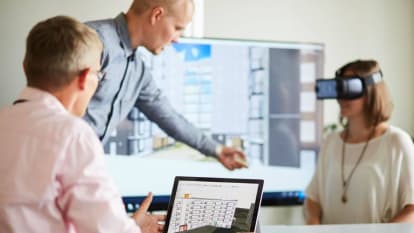Building the future with Virtual Reality
Virtual Reality (VR) is an important new technology also in the building industry. It already offers many possibilities and its development is advancing very rapidly, making the usage areas for us in NCC increase constantly.
Getting the experience before it exists
VR enables us to visualize our constructions and buildings before they are actually built. It makes it possible for us to show our clients the product we will deliver, and not just as a digitally constructed image, but in an environment where the client gets to experience the product as if they were standing in it themselves. 360-degree views and the ability to move around in the virtual environment offers a much more complete and accurate visual experience – closer to real life.
But VR is not only a huge benefit for our clients, we also use it during our design and production processes to improve and quality assure the project material.
Mixed reality – combining existing and new
On-site we are working with the benefits of "mixed" reality – or Augmented Reality (AR) as it is also sometimes called. In this digital environment we can mix virtual elements with existing and physically real elements. This ability has a huge potential helping coordination in production. For example, we can then visualize technical installations and check them in their right place before we install them.
Seeing a completely new building in its full extent on an empty construction site, before we even start up production – or having existing conditions and buildings combined with the end-result in for example refurbishment projects, is a potential we are going to see much more of in the near future.
Here are some of the areas where we are currently using Virtual (or mixed) Reality:
- Client meetings – visualizing the final project
- Design process – improving collaboration and decision making
- On-Site project coordination and quality assurance
- Combined visualization of existing and new in refurbishment projects
- Analyzing and simulating excavations and use of large machinery
Technologies used:
- InsiteVR
- Dalux TwinBIM
- HoloLens
- Hägring
- IrisVR
